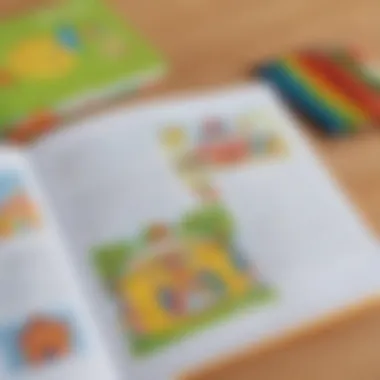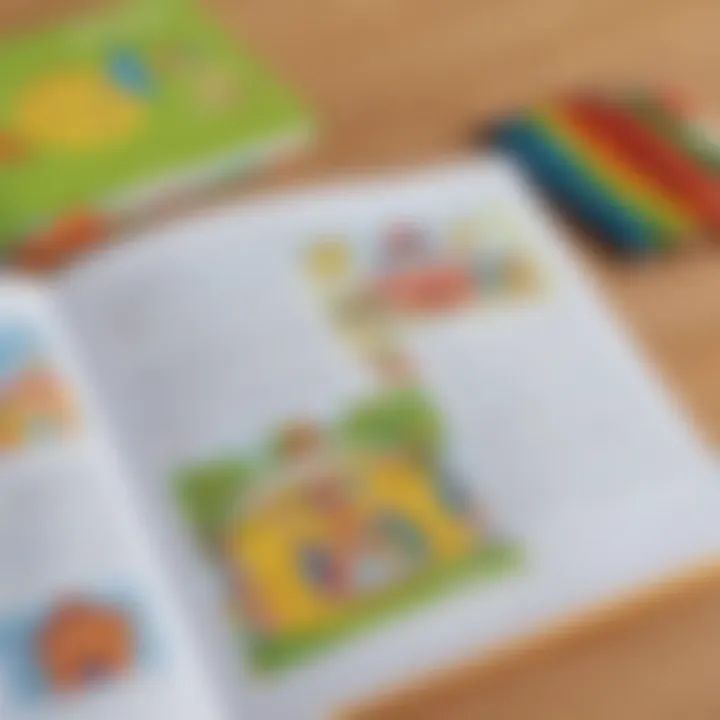Choosing the Best Workbook for Kindergarten Success


Intro
Choosing the right workbook for kindergarten can feel like searching for a needle in a haystack. With countless options out there, how do you pinpoint the one that suits your child best? A workbook isn't just a collection of pages; it's a tool that can unlock your child’s potential, nurturing their curiosity and laying a strong foundation for future learning.
This section will help simplify the selection process. We'll explore what to look for when picking a workbook, taking into account the child’s developmental stage, preferred learning styles, and the essential balance between keeping it fun and ensuring it’s educational. By keeping these factors in mind, parents, educators, and caregivers can make informed choices that enhance early childhood experiences.
In this article, we’ll dive into creative activities, engaging quizzes, and fact-based articles that can accompany workbooks to enrich learning. Each aspect contributes not just to academic growth but also to fostering a love for learning that lasts a lifetime.
Let’s first explore the realm of creative activities.
Understanding the Importance of Workbooks
When it comes to early education, the materials we choose can make all the difference in a child's learning journey. Workbooks, in particular, hold significant importance in laying the foundational skills necessary for kindergarten students. They act as both tools and resources that aid in honing various skills through structured, yet enjoyable, activities.
Why Workbooks Matter: Workbooks are not just about filling in the blanks or coloring within lines; they can transform abstract concepts into practical experiences. The tactile nature of workbooks provides children with a sense of accomplishment as they complete tasks, thereby boosting their confidence. Furthermore, these resources engage multiple senses, reinforcing learning in a way that’s memorable and effective.
In the context of this article, the focus on workbooks stems from their role in promoting essential cognitive and motor skills. Recognizing this importance allows parents and educators to make informed decisions about which workbook may suit a child's unique learning style. When evaluating workbooks, it's crucial to consider how they contribute to various aspects of development, establishing a balanced and engaging approach to learning.
The Role of Workbooks in Early Education
Workbooks offer structured learning experiences that align with developmental milestones in early childhood education. They introduce academic concepts through illustrations and interactive tasks, making learning feel more like play than work.
Consider the many roles a workbook can play:
- Skill Reinforcement: Regular practice enhances skill retention and understanding.
- Self-Paced Learning: Kids can work at a pace that feels comfortable for them, which decreases frustration and allows mastery before moving ahead.
- Assessment and Tracking: Workbooks can help in identifying strengths and weaknesses, providing valuable feedback for parents and teachers alike.
Ultimately, workbooks serve as a bridge between the structured environment of a classroom and the colorful, imaginative world of a child’s mind, fostering both academic and emotional growth.
Skills Development Through Workbook Activities
Workbook activities are designed with specific skills in mind, from basic motor skills to early literacy and numeracy. Such activities provide targeted practice that can help solidify core competencies essential for future learning.
Key Skills Developed:
- Literacy Skills: Activities focused on letter recognition and phonemic awareness lay the groundwork for reading.
- Numeracy Skills: Simple math exercises using objects and numbers enables comprehension of counting and basic operations.
- Fine Motor Skills: Tasks involving tracing, coloring, and cutting help children develop hand-eye coordination necessary for writing.
By engaging students in varied activities, workbooks cultivate not just academic skills but also critical thinking and problem-solving. Whether it’s through puzzles or creative exercises, each page offers an opportunity for learning in an engaging manner. Children, thus, aren’t just absorbing information; they’re actively participating in their education.
"Choosing the right workbook can spark a child’s interest in learning, making education a fun and rewarding journey."
Defining Educational Goals for Kindergarten
Defining educational goals for kindergarten is a cornerstone to shaping the learning experience of young children. These goals act as guiding stars, helping parents and educators navigate the complex landscape of early education. Since kindergarten lays the groundwork for future learning, clarity in objectives becomes essential. It ensures that students not only grasp fundamental concepts but also develop the skills necessary for more advanced learning as they progress.
Establishing specific educational goals fosters a structured environment where children feel secure in their learning journeys. It allows educators to tailor activities that align with children’s developmental stages, ultimately promoting a more effective teaching process. But it’s not just about academics; these goals also encompass social and emotional growth, which are crucial at this stage of development. Institutions and families working hand-in-hand can create a holistic approach to education.
Literacy and Numeracy Objectives
Literacy and numeracy objectives form the backbone of what kindergartners typically learn. When parents and educators articulate these goals clearly, they provide a framework that ensures consistency and depth in learning. Literacy skills—like recognizing letters, understanding sounds, and developing vocabulary—are critical as they prepare kids for reading and writing. These foundational skills pave the way for proficient communication later on.
Similarly, numeracy isn’t simply about numbers; it's about understanding quantities, patterns, and basic arithmetic. Activities that focus on counting, comparing numbers, or understanding shapes help cement these concepts. They stimulate critical thinking and enable children to make sense of their environment mathematically. For instance, using real-life situations like counting apples during a grocery trip or measuring ingredients for a simple recipe reinforces these essential skills naturally.
Social and Emotional Development
Social and emotional development is often overshadowed by academic goals, yet it’s equally vital. During kindergarten, children start to form connections with others, navigate emotions, and understand interpersonal dynamics. It's a time when they learn to share, empathize, and communicate their feelings. Thus, incorporating social-emotional learning objectives ensures that children become well-rounded individuals.
Through group activities or pair work, kids learn cooperation and conflict resolution. Role-playing can be one effective strategy to help them step into someone else's shoes, which cultivates empathy. For instance, acting out scenarios, such as sharing toys or resolving a disagreement, prompts discussions on feelings and solutions. This emotional literacy lays the foundation for healthy relationships in the future.
"Setting clear goals not only hones the cognitive skills of children but also shapes their character, enabling them to navigate a complex world with confidence."
In summary, thoughtful articulation of these educational objectives can yield a wealth of benefits, guiding both the curriculum and the learning experience.
Evaluating Workbook Content
In the world of early education, workbooks serve as a cornerstone for laying down the fundamental skills that kindergarten students will carry forth in their educational journeys. Evaluating workbook content is not merely an option; it's a necessity for parents and educators alike. When selecting a workbook, one must consider how well the content resonates with the developmental stages of children. Moreover, it's essential to ensure that these materials align with educational standards that can help track children's progress, making it easier to pinpoint areas where they may need additional support.
Age Appropriateness of Exercises
When it comes to selecting a workbook, the first step is scrutinizing the age appropriateness of its exercises. Workbooks pitched to kindergarteners should ideally engage a child's natural curiosity and align with their cognitive capabilities. If the exercises are too advanced or simplistic, they can either lead to frustration or dull interest, neither of which is beneficial.
Activities should encourage critical thinking and creativity rather than rote memorization. For instance, a good workbook might include puzzles that ask children to identify shapes, which not only reinforces geometric concepts but also promotes visual-spatial reasoning. Another example could be matching animals with their sounds; this integrates auditory skills with fun while ensuring age-appropriate engagement.
"Children learn best when they are both challenged and supported. The exercises should stimulate curiosity while being accessible."
Thus, gauging this balance in age appropriateness can significantly impact how effectively a child absorbs essential skills during these formative years.
Alignment with Educational Standards
Not all workbooks are created equal, especially when it comes to adhering to educational standards. Evaluating how well the workbook aligns with these standards is crucial for maximizing its effectiveness in developing core skills. These standards often dictate the necessary benchmarks in literacy, numeracy, and social skills that children should be achieving at specific stages.
An effective workbook should not merely follow an arbitrary list of exercises but rather should integrate learning objectives that reflect what children are expected to master by the end of the kindergarten year. For instance, if a workbook focuses on reading, it should feature activities that aid phonetic awareness—a skill emphasized in most educational frameworks.
Furthermore, such alignment facilitates smoother transitions into first grade, as children will have a solid foundation built on widely accepted pedagogical principles. Plus, it provides parents and teachers with a clear measure to evaluate a child's learning progress. The idea here is not just filling pages with tasks but fostering an environment that encourages educational growth in an intentional way.
In summary, evaluating workbook content is a crucial step that can significantly steer your child’s learning experience. By emphasizing age appropriateness and alignment with educational standards, you can ensure that the workbook you choose will support your child's developmental needs and set them on a path of learning success.
Examining Workbook Format and Structure


When it comes to selecting the right workbook for kindergarten learning, the format and structure play a pivotal role. These factors not only impact how the child interacts with the material but also influence their overall learning experience. A well-structured workbook caters to the diverse needs of young learners, supporting their developmental stages and learning styles. Understanding what to look for in terms of layout, visual appeal, and the variety of activities can make a significant difference in fostering a child’s enthusiasm for learning.
Layout and Visual Appeal
The layout and visual appeal of a workbook can grab the attention of a young learner faster than a splash of paint on a blank canvas. Children are naturally drawn to bright colors, fun illustrations, and a clean, organized presentation. An effective layout should balance aesthetic qualities with functionality.
- Eye-catching Graphics: Workbooks that include colorful images and playful fonts can make the learning process more enjoyable. When children see worksheets that look inviting, they’re more likely to engage with the content.
- Logical Organization: Information should be presented in a way that’s easy to follow. Pages that have too much clutter can cause confusion, making it harder for children to focus on the tasks at hand. For instance, having clear headings and sections helps guide the child through their learning journey without feeling overwhelmed.
- Appropriate Font Size and Style: Text should be easy to read. Large, clear fonts not only help in letter recognition but also reduce strain on young eyes. If the font is playful but impossible to decipher, it may hinder the learning process.
In summary, an effective workbook layout should not only be appealing but also promote clarity. A well-structured workbook creates an environment where learning can flourish, allowing kids to grasp concepts without unnecessary distractions.
Variety of Activities and Engaging Elements
A workbook should not be just pages of repetitive tasks; it needs to be a treasure trove of activities that spark curiosity and creativity in young minds. The best workbooks incorporate a blend of tasks that help develop various skills. Here’s why variety matters:
- Diverse Learning Styles: Every child learns differently, and providing an assortment of activities ensures that there’s something for everyone. Some children may thrive with hands-on tasks, whereas others might benefit from visual puzzles or verbal challenges.
- Active Engagement: Incorporating engaging elements such as games, coloring pages, or simple projects can turn mundane learning into exciting exploration. Think of a workbook that includes edible math or artistic science projects; these activities can make learning feel like an adventure.
- Skill Reinforcement: A well-rounded workbook offers activities that reinforce skills in multiple ways. For instance, pairing writing exercises with drawing tasks can help solidify fine motor skills while keeping lessons fresh and interesting.
Workbooks that blend a variety of activities not only maintain a child's interest but also promote comprehensive skill development that aligns with their growth.
These engaging elements help frame learning as a joyful experience, ensuring children remain eager to dive back into their studies. Ultimately, the format and structure of a kindergarten workbook shouldn't just be an afterthought; they should work hand-in-hand with content to create an effective learning tool.
Assessing the Assessment Techniques
Assessing how well a workbook handles different assessment techniques is a crucial part of selecting the right educational resource for young learners. It’s not just about the activities within the workbook but also how well these activities measure and enhance a child's understanding and capabilities. With kindergarten being such a formative stage, the types of assessments used can significantly influence a child's learning trajectory, establishing a solid foundation for future academic success.
When discussing assessment techniques, it’s important to distinguish between formative and summative assessments and how both contribute to a more rounded perspective on a child's learning.
Formative vs. Summative Assessments
Formative assessments are like checkpoints along the learning journey. They're less about grading and more about insight. Think of them as conversations with a child about their progress. A workbook that incorporates ample formative assessments typically includes activities that allow for ongoing evaluation of a child's understanding. For instance, a workbook may feature quick review questions following a section on colors, where children might match color names with pictures. This lets caregivers understand not only if the child grasps the material but also how they react to it.
On the other end of the spectrum are summative assessments, which usually occur at the end of a lesson or unit. They serve to measure what a child has learned. This could be a mini-test or a project that showcases the skills the child should have developed. However, while summative assessments are vital for assessing overall comprehension, they can also be anxiety-inducing for young kids. A workbook that balances these two types is often the best choice, ensuring that no child feels overwhelmed while still facilitating the chance to display their knowledge.
Feedback Opportunities for Improvement
Providing feedback is where the real magic happens in learning. Workbooks should not only present activities but also facilitate meaningful feedback that leads to improvement. Useful feedback can come in many forms—whether it’s simple smiley faces to indicate success or brief notes that suggest further areas for exploration.
- Purposeful Feedback: When feedback is constructive and specific, it highlights areas of strength while gently guiding learners toward improvement. For example, if a child labels a drawing of a dog as a “cat,” the feedback in the workbook might encourage them to look at other examples of dogs and colors, fostering a sense of discovery rather than confrontation.
- Scaffolding Improvement: By giving opportunities where children can correct their answers based on feedback, they feel more involved in their learning. A workbook featuring sections that allow children to revisit questions after receiving feedback can greatly enhance their confidence and competence.
In closing, selecting a workbook that appropriately addresses assessment techniques can make a world of difference. It not only sharpens the focus on what children have learned but also provides them with essential pathways for growth. When parents and caregivers take these considerations to heart, they can select materials that truly resonate with the young learner's journey.
"Effective assessment is not just a tool but a tutor that walks beside the child, illuminating the path to knowledge."
In summary, blending formative and summative assessments while ensuring feedback helps parents and educators understand how well a child is learning and what steps might be necessary for improvement.
Identifying the Most Effective Workbook Traits
When it comes to selecting the perfect workbook for kindergarten learning, certain traits make a significant difference in how effective that workbook will be. These characteristics can elevate a workbook from merely being a collection of exercises to a vital learning tool that genuinely engages young learners. Understanding these traits is essential for educators, parents, and caregivers intending to foster a love for learning.
Incorporation of Multi-Sensory Learning
The incorporation of multi-sensory learning into workbooks stands as a critical feature. Young children are naturally curious and often learn best when they can touch, see, and even hear what they are working on. A workbook that integrates various sensory modalities can help solidify concepts in children’s minds. For instance, a workbook with textures for them to feel while tracing letters or numbers enhances tactile learning, which is crucial at this age. It’s like giving kids a buffet of learning experiences rather than serving them the same plain meal.
Here are some vital elements of multi-sensory learning in workbooks:
- Visual Aids: Pictures, colors, and charts that grab attention.
- Tactile Activities: Textured pages or manipulatives that can be touched and moved around.
- Auditory Features: QR codes leading to songs related to a lesson for auditory reinforcement.
By engaging multiple senses, children are more likely to retain what they learn. A workbook that does not consider this aspect may miss the mark, turning what could be engaging sessions into mundane tasks.
Interactivity and Hands-On Activities
Equally important is the focus on interactivity and hands-on activities. Young learners thrive in environments where they can move and engage fully rather than be confined to paper-and-pencil tasks alone. Workbooks that facilitate active participation -- be it through drawing, cutting, pasting, or coloring -- can keep kids invested in the learning process.
The idea is simple: when children are invited to interact with their learning materials, they become actors in their own education rather than just spectators. For example, a workbook that includes activities where kids can create their own stories with illustrations encourages creativity and literacy skills. These types of engaging activities can make a workbook feel like a playground of knowledge.
Consider some of these features when evaluating a workbook’s interactivity:
- Prompted Activities: Tasks that encourage kids to think and create on their own.
- Illustrative Spaces: Blank areas for personal drawings or notes, enabling self-expression.
- Movement-Based Tasks: Activities that involve getting up and moving around can break up monotony.
In summary, the effectiveness of a workbook largely depends on its traits, specifically regarding multi-sensory integration and interactivity. When children can touch, see, and manipulate their learning materials, they enjoy the process significantly more, and the educational possibilities become endless.
"Engaging with material through multiple senses and interactive tasks transforms the learning experience from a chore into an adventure."
By focusing on these essential characteristics, parents and educators can ensure they are providing children with the best tools to initiate a lifelong love of learning.
Recommendations from Educational Experts
When it comes to selecting the right workbook for kindergarten learners, insights from educational experts are invaluable. These recommendations can help parents, educators, and caregivers make informed decisions that foster a better learning environment for young children.
Insights from Kindergarten Teachers
Kindergarten teachers are on the front lines of early education. Their daily interactions with children provide them with a unique perspective on what works and what doesn't in a workbook.
Teachers often stress the importance of engaging content that captivates a child's attention. They recommend workbooks that feature vibrant illustrations, relatable characters, and interactive elements. For example, a workbook that incorporates popular cartoons or themes that resonate with children can motivate them to participate actively.
Moreover, teachers emphasize the need for a variety of activities, which cater to different learning styles. One child might grasp concepts quickly through visuals, while another may need hands-on activities.
"The more senses we engage, the more pathways we create for learning. Workbooks should complement what we do in the classroom, not just repeat it."
— A seasoned kindergarten educator
It's also crucial for workbooks to include easy-to-follow instructions. Kindergarten kids are just stepping into independent learning, so clarity helps them understand what’s expected.


Advice from Child Development Specialists
Child development specialists bring a broader understanding of cognitive and emotional growth. Their advice often centers around age-appropriateness and overall developmental suitability. They assert that children in kindergarten are at a stage where play and learning are intertwined.
An effective workbook should balance educational rigor with elements of fun. For instance, a workbook that prompts kids to draw or color while learning numbers enriches their fine motor skills while keeping the process enjoyable.
In terms of emotional development, specialists advise looking for workbooks that promote self-expression, such as activities that allow kids to share their thoughts or solve problems creatively. This supports not just knowledge acquisition but also social skills.
When approaching a workbook selection, experts encourage parents to review the materials alongside their children. This can foster a sense of shared learning and help identify which themes or activities your child gravitates towards. By aligning workbook activities with your child’s interests, you are likely to enhance their motivation and retention.
Overall, recommendations from educators and child specialists hold pivotal importance when selecting a workbook. Their collective insights illuminate the avenues towards optimum learning experiences, ensuring that children not only learn but also thrive in their educational journey.
Selecting Publisher Credibility
When it comes to the world of educational workbooks, selecting a credible publisher is akin to finding a trustworthy guide in an unfamiliar terrain. The publisher's reputation not only reflects the quality of the materials produced but also assures parents and educators that the content is both reliable and effective for young learners.
Reputation and Experience in Educational Publishing
Choosing a workbook from a reputable publisher sets the stage for optimal learning experiences. Publishers with a solid track record often invest in research and development, ensuring their materials meet the specific needs of kindergarten children. Moreover, an experienced publisher likely has a deep understanding of educational standards and evolving teaching methodologies.
An established name in educational materials—like Scholastic or Carson-Dellosa—may showcase a wealth of resources for various learning styles. These publishers are more inclined to offer age-appropriate content and methods that are not only pedagogically sound but also engaging for children. In other words, a well-regarded publisher likely puts a lot of effort into vetting their content, ensuring it aligns with important educational frameworks and developmental stages.
User Reviews and Feedback Analysis
In today's digital age, customer reviews hold significant weight and can provide insight into how a workbook performs in real learning environments. Websites, forums, and social media platforms offer a plethora of customer feedback. For instance, parents may share their insights and experiences on platforms like reddit.com or specialized education forums. These conversations can expose potential issues or highlight strengths about particular workbooks.
- Seek diverse opinions: It's beneficial to read both positive and negative reviews. While glowing testimonials are great, critical feedback can highlight redraws or gaps that might otherwise be overlooked.
- Focus on detailed feedback: Look for reviews that elaborate on specific workbook features, like layout, clarity of instructions, or adaptability to different learning styles.
- Consider expert opinions: Check if educational professionals have weighed in. Teachers and child development specialists may provide a perspective that's not only informative but crucial in assessing the workbook's quality.
"In a sea of options, the voices of others can help us steer clear of potential missteps and guide us towards alternatives that are truly effective."
When compiling user reviews, one might want to create a simple matrix to weigh the positives and negatives of different workbooks. This not only enhances decision-making but also contributes to selecting the right resource for nurturing a kindergarten child's learning journey.
Understanding the Role of Parents and Caregivers
When it comes to the education of young children, the involvement of parents and caregivers cannot be overstated. They are not just passive spectators; they play a critical role in shaping a child’s attitude toward learning and their overall educational experience. This section explores how parents and caregivers can significantly influence the selection and effective use of workbooks in a kindergarten context.
Engagement in Learning Processes
One of the most vital aspects that parents and caregivers provide is their engagement in the learning process. When children see their parents actively participating in their education, it sends a powerful message about the value of learning.
- Modeling Attitudes: Parents who show enthusiasm for workbooks and related activities can inspire their children. If parents express excitement when starting a new workbook, children are more likely to mirror that enthusiasm.
- Creating a Learning Environment: Establishing a conducive learning atmosphere at home is crucial. Setting aside a quiet space with all the necessary materials can create a routine that transforms learning into a seamless part of daily life. This consistent engagement can help children develop crucial study habits early on.
- Participating Together: Working through workbook exercises as a team encourages discussions about the content, leading to a deeper understanding. Whether it’s counting animals or identifying letters, joint participation not only reinforces learning but also elevates bonds between the child and caregiver.
"Involvement isn’t just about helping with homework; it’s about being a part of the educational journey and encouraging inquisitiveness."
Utilizing Workbooks at Home Effectively
Adopting workbooks at home offers an array of benefits, but they must be used properly to be effective. Here are some ways parents can optimize workbook usage:
- Routine Matters: Sticking to a consistent schedule for workbook activities helps children anticipate learning sessions. Whether it’s after school or before bedtime, routine creates a rhythm children find comforting and familiar.
- Personalized Approach: Not every workbook will cater to every child’s needs. Parents should observe their child’s interests and struggles. If a child loves animals, opting for a workbook with more animal-related activities might pique their interest and lead to better retention.
- Feedback and Encouragement: As children complete activities, providing positive feedback boosts their confidence. A simple "Great job!" or "I love how you did that!" encourages children to tackle the next challenge with enthusiasm.
- Integration with Real Life: Link workbook activities to real-world situations. If a workbook exercise involves counting, take a walk outside and count things in nature together. This not only reinforces learning but makes it relatable and enjoyable.
Exploring Alternative Learning Materials
When it comes to kindergarten learning, understanding that workbooks are just one piece of a larger puzzle is vital. Parents and educators should be aware that exploring alternative learning materials can not only enhance the educational experience but also cater to diverse learning styles and preferences. Whether through hands-on activities, digital formats, or supplementary resources, the goal remains consistent: to foster a well-rounded approach to early education.
Digital Formats and Interactive Apps
In today’s tech-savvy world, incorporating digital formats and interactive apps into learning routines can be a game-changer. These tools offer dynamic interfaces that can keep young learners engaged, often utilizing gamification to teach fundamental concepts. A big advantage is that these apps often adapt to the child's progress, providing personalized feedback and challenges tailored to their pace. Here are some specifics to consider:
- Engagement Factor: Young learners are naturally drawn to screens, so providing educational apps promotes effective engagement. This means they are more likely to invest time in learning without it feeling like a chore.
- Immediate Feedback: Apps can offer instant gratification through quizzes or skill games, allowing kids to see their progress reflected in real time. This immediate response can motivate them further.
- Accessibility: Digital materials often come with flexible platforms. For example, a parent can download a few apps on a tablet, which can be used anywhere—from a cozy corner in the home to a long trip.
However, it’s essential to ensure that any digital content is age-appropriate and aligns with educational objectives. Moderation is key; too much screen time can be counterproductive.
Supplemental Resources to Enhance Learning
Utilizing supplemental resources can round out the learning experience and offer additional pathways to understanding. These resources often complement traditional workbooks by reinforcing concepts in a more hands-on manner or by providing broader context. Here are a few examples:
- Physical Materials: Think about incorporating items like flashcards, puzzles, or manipulatives like counting blocks. These tactile resources can help solidify concepts through action, which is particularly beneficial for kinesthetic learners.
- Reading Materials: Picture books that illustrate concepts found in workbooks can further deepen understanding. For instance, if a workbook covers shapes, finding storybooks that highlight shapes in everyday life can connect learning to the real world.
- Community Resources: Local libraries or community centers often host learning events or offer materials that support educational themes. Engaging children in these ways can expand their horizons and reinforce what they learn through workbooks.
"Think outside the box with learning materials, enhancing traditional methods can lead to a richer educational experience."
Potential Challenges with Workbooks
Selecting a workbook for kindergarten students isn't all sunshine and rainbows. While workbooks serve as valuable tools in early education, there are a number of challenges that parents and educators must navigate. It's crucial to understand these potential hurdles to make informed decisions that truly benefit young learners. This section takes a deep dive into the issues that can arise during workbook selection and utilization, empowering caregivers to choose resources that support children's growth effectively.
Common Pitfalls in Workbook Design
When it comes to workbook design, not all are created equal. Some common pitfalls can undermine their educational efficacy:
- Overly Complex Activities: Often, workbooks contain activities that are too challenging for kindergarteners. This complexity can lead to frustration and disengagement. Watch out for tasks that require writing or comprehension skills beyond the child's current abilities.
- Lack of Variety: A workbook that only focuses on one type of activity can quickly grow stale. Kids thrive on variety—if they only see worksheets upon worksheets of the same kind, their enthusiasm may wane. Activities should cover a range of subjects and skills to keep learning fresh and stimulating.
- Poor Visual Presentation: Children are drawn to colorful and engaging layouts. If a workbook is cluttered or lacks visual appeal, it’s less likely to grab a child’s attention. Visual clutter can also lead to confusion, making it difficult for learners to focus on the tasks at hand.
Being aware of these pitfalls can help parents avoid books that might frustrate rather than facilitate. Choosing workbooks with age-appropriate designs and engaging content can establish a firm foundation for children's learning.
Overcoming Resistance from Young Learners
Children naturally resist activities they find dull or difficult. Resistance to workbooks can manifest in various ways—from pushing the workbook away to outright tantrums. Addressing such resistance requires patience and understanding:
- Make It Interactive: Instead of simply handing over a workbook, parents can incorporate some fun elements. For instance, turning workbook activities into games can boost enthusiasm. This could mean using stickers as rewards for completed tasks or finding ways to turn a math exercise into a scavenger hunt.
- Offer Choices: Presenting children with a choice of which activities to do can foster a sense of autonomy. Allowing them to pick a workbook from a selected few can also make them feel more in control of their learning journey.
- Connect to Real Life: Help children see the relevance of what they're learning. For example, if a workbook lesson involves counting, parents can engage children by counting objects around the house, like crayons or toys. This real-world connection helps demystify workbook activities, making them feel more applicable and less like a chore.
- Be Patient: It's essential to maintain a positive attitude and not force too much all at once. Take breaks when needed, and be sure to praise even the smallest efforts to instill confidence in their abilities.


By understanding the various aspects of resistance and employing strategies to engage children more effectively, parents and educators can foster a more conducive learning environment.
"The aim of education is the knowledge, not of facts, but of values." – William S. Burroughs.
Acknowledging challenges in workbook selection and use can lead to more enriching experiences for young learners, allowing them to thrive in their educational settings.
Integrating Workbooks with Other Educational Tools
Integrating workbooks with a variety of educational tools can greatly enhance the learning journey for kindergarten students. It is important to recognize that workbooks alone might not address every aspect of a child's learning needs. Therefore, when selected thoughtfully, workbooks become a vital part of a larger educational framework that includes other resources and methodologies.
When we talk about integrating workbooks with other tools, we often refer to adding layers of learning that cater to different skills and approaches. This might include visual aids, hands-on materials, and digital resources. Combining these elements not only enriches a child's educational experience but also fosters better retention and understanding.
Some benefits of this integration can include:
- Varied Learning Styles: Children absorb information differently. Some learn best through reading and writing, while others may grasp concepts through visuals or physical activities. By offering a range of tools, you cater to each child's preferred learning style.
- Real-World Connections: Using supplementary materials such as objects from the environment or digital apps can help children connect workbook exercises to real-life situations, making learning more relevant and engaging.
- Engagement Through Variety: Mixing up the educational tools keeps children from becoming bored with a singular method of learning. It maintains their interest and motivation, which is particularly critical in early education.
Cross-Disciplinary Approaches to Learning
Cross-disciplinary approaches allow children to draw connections between different subject areas, solidifying their understanding. For instance, integrating math into a science project, or storytelling into a language arts exercise can facilitate a more holistic learning atmosphere. This enriches their workbook experience. A workbook that includes exercises applicable to various subjects helps children see the big picture of their education.
Not only does this method encourage critical thinking, but it also nurtures creativity. When children engage with math within a story context, they might better understand numerical concepts, enhancing analytical skills as they connect different dots. Creating opportunities for cross-disciplinary approaches means engaging young learners in these ways:
- Project-Based Learning: Assign projects that allow kids to use their workbooks alongside creative materials and discussions.
- Thematic Units: Create themes that link different subjects. A
Measuring Success and Effectiveness
In the journey of educating kindergarten students, the measurement of success and effectiveness becomes essential. This encompasses more than simply noting if children can count to ten or recite their ABCs. It involves a deeper understanding of their overall development and learning trajectory. Evaluating how well a workbook supports a child’s progress offers insight into its appropriateness and value, crucial for selecting the right materials.
An effective workbook should foster a child's skills while also allowing parents and educators to ascertain whether learning goals are being met. This tracking process acts like a compass, guiding instruction and support. What parents often overlook is that the impact of a workbook does not just stop at its pages; it extends to the child’s growth and engagement.
"Success isn't just about what you accomplish in life, it's about what you inspire others to do." – Unknown
Tracking Progress and Mastery of Skills
Keeping tabs on a child's progress can seem daunting, but it doesn’t have to be. A good workbook will provide various exercises that can illuminate whether a child is grasping concepts. Parents and teachers should consider tracking elements such as:
- Frequency of use: How often is the child engaging with the workbook?
- Error patterns: Are there consistent mistakes in specific areas that indicate a need for further instruction?
- Completion rate: Are the exercises completed with enthusiasm or reluctance?
- Skill mastery: Has the child transitioned from guided practices to independent work on similar tasks?
These observations can then be transformed into actionable plans. Suppose a child struggles with basic addition. This isn’t just a small bump in the road; it signals to both parent and teacher that additional reinforcement might be necessary. Rather than just moving on to the next concept, it's about circling back, using supportive tools, and ensuring the foundation is solid.
Adjusting Approaches Based on Outcomes
Measuring success is not a one-off task. It’s an ongoing aspect of educational development. When outcomes suggest that a workbook isn’t hitting the mark, adjustments are vital. These modifications could include:
- Shifting resources: If one workbook doesn’t align well with a child's learning style, considering alternatives that offer more visual components or hands-on activities may yield better results.
- Incorporating feedback: Engaging with the child to understand their feelings about the workbook can provide insights that numbers alone cannot. Sometimes hearing a child's perspective can reveal where the workbook may lack engagement.
- Adapting teaching strategies: If certain skills aren’t being mastered as expected, altering the teaching approach to include more play or reality-based learning might be more effective.
By fine-tuning educational approaches based on these assessments, stakeholders can ensure they are providing the best possible support for young learners. The goal isn't merely to fill out pages but to cultivate an enriching, supportive educational environment.
Final Thoughts on Choosing a Workbook
Choosing the right workbook for kindergarten isn’t just about picking a book off the shelf. It’s about understanding a child's individual learning journey. Each workbook should ideally serve as a bridge, connecting the child’s innate curiosity with structured learning opportunities. By crafting an adventure that finds the sweet spot between education and engagement, parents, educators, and caregivers set the stage for long-lasting learning experiences in young minds.
Summarizing Key Considerations
As we near the end of this exploration into selecting the optimal workbook, it’s crucial to distill the main elements contributing to effective learning:
- Developmental Appropriateness: The workbook needs to fit the child’s age and stage of development. Exercises should not only be stimulating but also doable, avoiding frustration while encouraging a sense of accomplishment.
- Engaging Content: Look for workbooks that feature vibrant illustrations, interesting themes, and varied activities. If a child finds the material enjoyable, they are more likely to engage with it consistently.
- Skill Alignment: The contents of the workbook should align with educational objectives, including literacy, numeracy, and even social skills. It’s essential that the workbook contains activities that are relevant to what’s being taught in classrooms.
- Feedback Mechanisms: Assessing learning isn’t just about right or wrong answers. Workbooks that encourage reflection and provide space for feedback help children understand their progress and areas needing growth. Such feedback can be invaluable for caregivers as well.
- Flexibility and Adaptability: A good workbook will not be too rigid. Instead, it should allow for adjustments based on the child's evolving needs. Easy-to-use formats that offer guided instruction or choices will enhance their learning experience.
These considerations form the backbone of a well-rounded approach to workbook selection. Each aspect plays a vital role in leveraging the educational potential of workbooks, ensuring that children not only learn but thrive while doing so.
Encouraging Continuous Learning and Adaptation
Learning is not a one-time event, especially in the critical earlier years. It’s a continuous evolution, where one concept builds on another. As such, encouraging continuous learning through workbook use can be incredibly fruitful. Some ideas to promote this include:
- Setting Goals: Work with the child to set achievable learning targets. This not only keeps them motivated but also fosters a sense of responsibility for their learning.
- Flexibility: Adapt the workbook activities based on the child’s engagement and comfort level. If certain tasks spark joy and curiosity, it’s wise to explore those areas further.
- Using Feedback for Growth: Promote a culture where feedback is seen as a helpful guide rather than a set back. Discussing what they liked or found challenging helps children form better learning habits.
- Supplemental Learning: Don’t just stop at workbooks. Incorporate other learning materials like educational games, interactive apps, or hands-on activities related to the workbook content. This can reinforce concepts and provide a rich tapestry of learning opportunities.
"Education is the most powerful weapon which you can use to change the world." – Nelson Mandela
By fostering an atmosphere where learning is seen as an ongoing journey, parents and caregivers can inspire a lifelong passion for knowledge in children. Remember, each workbook can serve as a stepping stone on this path, setting the foundation for success in future lessons.
Resources for Further Exploration
Understanding how to select the best workbook for kindergarten learning is just the start of a parent or educator's journey. Resources for further exploration play a pivotal role in expanding knowledge and boosting the decision-making process regarding educational materials. This section will underscore the importance of seeking additional materials that can refine understanding and shed light on various approaches to early childhood education.
By tapping into diverse resources, parents can gain insights and tools needed to create a conducive learning environment. Right resources not only offer theoretical frameworks but also provide practical examples and creative strategies to engage young learners. Here's how the journey continues:
Books and Articles on Early Education
Books and articles focused on early education serve as a treasure trove of information for parents and educators alike. They cover a wide array of topics, from developmental psychology to effective teaching strategies. Here are a few vital benefits of diving into such literature:
- Foundational Knowledge: Readers can develop a solid base of understanding about child development stages, which is crucial when selecting the right workbook.
- Diverse Perspectives: Many authors approach early education with different philosophies. Reading diverse viewpoints helps in formulating a well-rounded approach to learning.
- Practical Strategies: Books often contain actionable tips that can easily be applied to real-life situations, enhancing the learning experience.
Examples of valuable books include "The Whole-Brain Child" and "Teach Your Child to Read in 100 Easy Lessons", both of which offer insights that could align with workbook strategies. Articles published in educational journals often present the latest research, making them a critical addition to any reading list.
Educational Websites and Online Communities
The online realm now hosts a wealth of information that can aid parents and educators. Educational websites and online communities are particularly beneficial for several reasons:
- Accessibility: These platforms offer 24/7 access to resources, making it easy to browse through tips, worksheets, and advice at any time.
- Interactive Learning: Many websites include interactive tools, such as quizzes and videos, which can make understanding material much easier and more engaging.
- Community Support: Online communities such as Reddit or educational forums provide spaces for parents and educators to share experiences and strategies. Engaging with peers can also provide moral support and encouragement.
Websites like britannica.com or en.wikipedia.org can give solid foundational knowledge, while communities on platforms like reddit.com or dedicated Facebook groups can serve as a sounding board for ideas and resources.
"Asking questions and participating in discussions can illuminate aspects of learning you might not have considered before."
Engaging with further resources not only aids in selecting the right kind of workbook but enriches the overall educational experience for children. Whether it’s through books offering deep dives into theory or websites providing practical tips, continuing to learn is paramount.







